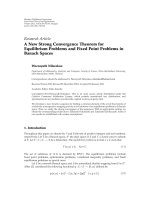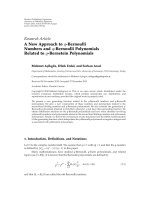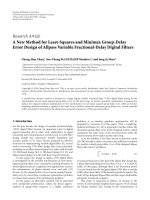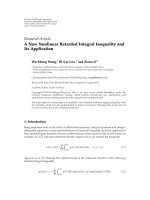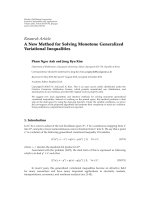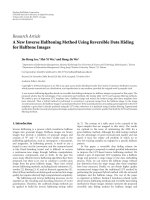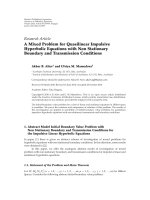Báo cáo hóa học: " Research Article A New Method for Least-Squares and Minimax Group-Delay Error Design of Allpass Variable Fractional-Delay Digital Filters" pdf
Bạn đang xem bản rút gọn của tài liệu. Xem và tải ngay bản đầy đủ của tài liệu tại đây (1.5 MB, 10 trang )
Hindawi Publishing Corporation
EURASIP Journal on Advances in Signal Processing
Volume 2010, Article ID 976913, 10 pages
doi:10.1155/2010/976913
Research Article
A New Method for Least-Squares and Minimax Group-Delay
Error Design of Allpass Variable Fractional-Delay Digital Filters
Cheng-Han Chan,
1
Soo-Chang Pei (EURASIP Member),
2
and Jong-Jy Shyu
3
1
Department of Aviation and Communication Electronics, Air Force Institute of Technology, Kaohsiung 820, Taiwan
2
Department of Electrical Engineering, National Taiwan University, Taipei 106, Taiwan
3
Department of Electrical Engineering, National University of Kaohsiung, Kaohsiung 811, Taiwan
Correspondence should be addressed to Jong-Jy Shyu,
Received 28 February 2010; Accepted 22 December 2010
Academic Editor: Douglas O’Shaughnessy
Copyright © 2010 Cheng-Han Chan et al. This is an open access article distributed under the Creative Commons Attribution
License, which permits unrestricted use, distribution, and reproduction in any medium, provided the original work is properly
cited.
A double-loop iterative method is proposed to design allpass variable fractional-delay (VFD) digital filters basing on the
minimization of root-mean-squared group-delay error. In the inner loop, an iterative quadratic optimization is proposed to
replace the original nonlinear optimization for the minimization of root-mean-squared group-delay error, while an iterative
weighting-updated technique is applied in the outer loop to further reduce the maximum group-delay error. Several examples
will be presented to demonstrate the effectiveness and good convergence of the proposed method.
1. Introduction
For the past decade, the design of variable fractional-delay
(VFD) digital filters became an important topic in digital
signal processing due to their wide applications in signal
processing and communication systems such as comb filter
design, sample rate conversion, tunable modulator and
acoustic system [1–5]. Since Farrow proposed an effective
structure for implementing variable digital filter [6], several
works concerning VFD filter design have been presented,
including an excellent tutorial paper by Laakso, and so forth
[7], FIR-based design [8–11], IIR-based design [12, 13]and
allpass-based design [14–24] with their respective feature.
In this paper, the design of allpass VFD digital filters
is investigated on the possible minimization of root-mean-
squared group-delay error. Among the existing literature in
which allpass structure is applied, most applications concern
the minimization of phase-oriented error, and only [23]
focuses on the minimization of root-mean-squared group-
delay error by converting a nonlinear optimization problem
to a linear least-squares (LS) optimization problem.
In this paper, an alternative method will be presented
with comparable performance. Likely, the direct approx-
imation of group-delay response is a highly nonlinear
problem, so an iterative quadratic optimization will be
proposed to overcome it in this paper. Then a weighting-
updated technique [11, 25] is proposed to further reduce the
maximum group-delay error of the designed system, which
constitutes the outer loop of the overall process while the
iteration stated above makes up the inner loop.
As to the stability, it has been shown in previous works
[26–29] that there exists a necessary and sufficient condition
for positive-valued group delay τ(ω) of the designed allpass
filter with order N as follows:
2π
0
τ
(
ω
)
dω = 2πN. (1)
It is also pointed out in [26] that if the allpass filter design has
a phase approximating error less than π at ω
= π it must be
stable. In this paper, although there is no theoretical proof,
it can be found that the designed allpass VFD filter is usually
stable when mean delay of the desired response is equal to the
order of the designed allpass filter and the range of adjustable
parameter is properly assigned.
This paper is organized as follows. In Section 2, the
review of conventional weighted least-squares (WLS) design
(as Deng’s method [21]) basing on the minimization of
2 EURASIP Journal on Advances in Signal Processing
phase-oriented error and frequency-response-oriented error
is given, and it will be shown that both will lead to the same
solution. The formal formulation for LS group-delay error
design of allpass VFD filters will be presented in Section 3,in
which an iterative method is proposed to replace the original
nonlinear optimization of group-delay-oriented error. Then
in Section 4, a weighting-updated technique is proposed to
further reduce the maximum group-delay error, and design
examples will be given to demonstrate the effectiveness and
good convergence of the proposed double-loop iterative
method. Also, an example with a different range of the
adjustable variable is given to show the significant effect on
overall performance, which has also been revealed in [14, 24].
Finally, the conclusions are given in Section 5.
2. Review of Deng’s Method of Allpass VFD
Digital Filters
For the design of an allpass VFD digital filter as in [21], the
desired frequency response can be given by
H
d
ω, p
=
e
−j(N+p)ω
, |ω|≤ω
p
,(2)
where p is the parameter used to adjust fractional delay and
N denotes the order of the designed allpass filter. The transfer
function of an allpass VFD digital filter is characterized by
H
z, p
=
z
−N
A
z
−1
, p
A
z, p
,(3)
where
A
z, p
= 1+
N
n=1
a
n
p
z
−n
,(4)
and the coefficients a
n
(p) are expressed as the polynomials
of p
a
n
p
=
M
m=1
a
(
n, m
)
p
m
,(5)
so (3)becomes
H
z, p
= z
−N
1+
N
n=1
M
m=1
a
(
n, m
)
p
m
z
n
1+
N
n
=1
M
m
=1
a
(
n, m
)
p
m
z
−n
(6)
which can be implemented by the structure shown in
Figure 1. Comparing with the structures in [15, 19]in
which all elements are processed once for each input data,
the proposed structure is designed such that the coefficient
generator will generate an updated coefficient only on the
demand of variation and the values of coefficients can be
stored in memory, which can save enormous computation.
By (6), the frequency response of the designed system is
H
e
jω
, p
=
e
−jNω
A
e
−jω
, p
A
e
jω
, p
=
e
−jNω
1+
N
n
=1
M
m
=1
a
(
n, m
)
p
m
e
jnω
1+
N
n
=1
M
m
=1
a
(
n, m
)
p
m
e
−jnω
(7)
which is used to approximate (2)asmuchaspossibleover
the region R
={(ω, p), 0 ≤ ω ≤ ω
p
, −0.5 ≤ p ≤ 0.5}.
2.1. Phase-Oriented Approximation. Due to the unit magni-
tude gain for allpass filters, the design problem can focus on
the phase approximation, that is, the phase of (7)
arg
H
e
jω
, p
=−
Nω−2arg
A
e
jω
, p
,
ω, p
∈
R,
(8)
will be desirable to approximate the phase of (2)
arg
H
d
ω, p
=−
Nω− pω,
ω, p
∈ R,(9)
so the error function can be represented by
e
θ
ω, p
=
arg
H
d
ω, p
−arg
H
e
jω
, p
=
2arg
A
e
jω
, p
−
pω.
(10)
2.2. Frequency-Response-Oriented Approximation. An alter-
native view point of the design problem is the direct
approximation of (2)by(7), that is, the error function is
given by
e
FR
ω, p
=
H
d
ω, p
−H
e
jω
, p
=
e
−j(N+p)ω
−e
−jNω
e
−j2arg(A(e
jω
,p))
= e
−j(N+p)ω
1 −e
−j(2 arg(A(e
jω
,p))−pω)
=
e
−j(N+p)ω
1 −e
−je
θ
(ω,p)
=
e
−j(N+p)ω
1 −cos
e
θ
ω, p
+ j sin
e
θ
ω, p
.
(11)
For good approximation, e
θ
(ω, p) ≈ 0, (ω, p) ∈ R,so
e
FR
ω, p
≈
e
−j(N+p)ω
je
θ
ω, p
=
e
θ
ω, p
,
ω, p
∈
R.
(12)
Hence, both phase- and frequency-response-oriented ap-
proximations will lead to the same solution.
2.3. WLS Solution of the Design Problem. By (10),
e
θ
ω, p
=−
2tan
−1
N
n=1
M
m=1
a
(
n, m
)
p
m
sin
(
nω
)
1+
N
n
=1
M
m
=1
a
(
n, m
)
p
m
cos
(
nω
)
− pω
(13)
which is desirable to approximate zero over R, and the prob-
lem can be converted into
−
N
n
=1
M
m
=1
a
(
n, m
)
p
m
sin
(
nω
)
1+
N
n=1
M
m=1
a
(
n, m
)
p
m
cos
(
nω
)
−→ tan
pω
2
=
sin
pω/2
cos
pω/2
,
ω, p
∈
R,
(14)
EURASIP Journal on Advances in Signal Processing 3
where “
→” means “approximate.” Equation (14)canbe
further replaced by
sin
pω
2
+
N
n=1
M
m=1
a
(
n, m
)
p
m
cos
(
nω
)
sin
pω
2
+sin
(
nω
)
cos
pω
2
−→
0,
ω, p
∈ R.
(15)
Hence, the root-mean-squared objective error function for
WLS design of an allpass VFD digital filter can be represented
by
e
c
(
a
)
=
0.5
−0.5
ω
p
0
W
(
ω
)
sin
pω
2
+ a
T
b
ω, p
2
dωdp
= s
b
+ r
T
b
a + a
T
Q
b
a,
(16)
where W(ω) is a positive-valued weighting function, the
superscript T denotes the transpose operator,
a
=
[
a
(
1.1
)
, , a
(
N, M
)
]
T
,
b
ω, p
=
p
cos
(
ω
)
sin
pω
2
+sin
(
ω
)
cos
pω
2
, ,
p
M
cos
(
Nω
)
sin
pω
2
+sin
(
Nω
)
cos
pω
2
T
,
s
b
=
0.5
−0.5
ω
p
0
W
(
ω
)
sin
2
pω
2
dωdp,
r
b
= 2
0.5
−0.5
ω
p
0
W
(
ω
)
sin
pω
2
b
ω, p
dωdp,
Q
b
=
0.5
−0.5
ω
p
0
W
(
ω
)
b
ω, p
b
T
ω, p
dωdp,
(17)
and the quadratic minimization of (16)willresultin
a
=−
1
2
Q
b
−1
r
b
. (18)
3. LS Group-Delay Error Design of Allpass VFD
Digital Filters
In this section, a delay-oriented approximation for designing
allpass VFD digital filters will be proposed. The desired
group-delay response can be obtained by
τ
d
ω, p
=−
∂
∂ω
arg
H
d
ω, p
=
N + p, (19)
and the actual delay response of the designed system is
τ
H
ω, p
=−
∂
∂ω
arg
H
e
jω
, p
=
N +2
∂
∂ω
arg
A
e
jω
, p
=
N−2
1+ a
T
c
ω, p
a
T
s
d
ω,p
−
a
T
c
d
ω, p
a
T
s
ω,p
1+a
T
c
ω, p
2
+
a
T
s
ω, p
2
,
(20)
where
c
ω, p
=
p cos
(
ω
)
, , p cos
(
Nω
)
, , p
M
cos
(
ω
)
, , p
M
cos
(
Nω
)
T
,
s
ω, p
=
p sin
(
ω
)
, , p sin
(
Nω
)
, , p
M
sin
(
ω
)
, , p
M
sin
(
Nω
)
T
,
c
d
ω, p
=
∂
∂ω
c
ω, p
,
s
d
ω, p
=
∂
∂ω
s
ω, p
.
(21)
Obviously, the objective error function for a delay-oriented
approximation can be represented by
e
τ
(
a
)
=
0.5
−0.5
ω
p
0
W
(
ω
)
τ
d
ω, p
−τ
H
ω, p
2
dωdp
=
0.5
−0.5
ω
p
0
W
(
ω
)
×
p +2
A
1+a
T
c
ω, p
2
+
a
T
s
ω, p
2
2
dωdp,
(22)
where A denotes (1 + a
T
c(ω, p))(a
T
s
d
(ω, p)) − (a
T
c
d
(ω,
p))(a
T
s(ω, p)).
However, the direct minimization of (22) is highly
nonlinear, so an iterative method is proposed to solve it
in this section and the objective error function in the kth
iteration becomes
e
k
(
a
k
)
= e
τ,k
(
a
k
)
+ αe
c,k
(
a
k
)
=
0.5
−0.5
ω
p
0
W
(
ω
)
A
2
k
−1
ω, p
p +2A
R,k−1
ω, p
a
T
k
s
d
ω, p
−
2A
I,k−1
ω, p
a
T
k
c
d
ω, p
2
dωdp
+ α
s
b
+ r
T
b
a
k
+ a
T
k
Q
b
a
k
,
(23)
4 EURASIP Journal on Advances in Signal Processing
Table 1: Comparison of evaluated errors in (29).
Method
ε
τ2
(%) ε
τ
ε
θ2
(%) ε
θ
Design time (seconds)
Deng’s method in Section 2, W(ω) = 1, p ∈ [−0.5, 0.5]
0.242 0.03145 0.001205 0.0001788 0.38
Lee, Caccetta, and Rehbock’s method [23], LS design,
p
∈ [−0.5, 0.5]
0.0992 0.005276 0.002199 0.0000718 3.19
Proposed LS design, p
∈ [−0.5, 0.5]
0.1474 0.004137 0.002312 0.0000707 28.36
Proposed LS design, p
∈ [−0.65, 0.35]
0.04464 0.001927 0.000724 0.0000543 28.13
Lee, Caccetta and Rehbock’s method [23], WLS design,
p
∈ [−0.5, 0.5]
0.155 0.002836 0.00307 0.0000838 58.63
Proposed minimax design, p
∈ [−0.5, 0.5]
0.1964 0.002966 0.003235 0.0000834 148.76
Proposed minimax design, p
∈ [−0.65, 0.35]
0.0664 0.001189 0.001141 0.0000365 196.56
Z
−1
x(n)
y(n)
−1
Z
−1
Z
−1
Z
−1
Z
−1
Z
−1
Z
−1
Z
−1
Z
−1
Z
−1
a
5
(p) a
4
(p)
a
3
(p)
a
2
(p) a
1
(p)
(a)
p
a(n,4) a(n,3) a(n,2) a(n,1)
a
n
(p)
(b)
Figure 1: (a) The proposed structure of an allpass VFD digital filter (N = 5,M = 4). (b) Coefficient generator (1 ≤ n ≤ 5).
4.14
4.16
ε
τ
4.18
4.2
4.22
4.24
4.26
0 500 1000 1500
α
2000
×10
−3
(a)
7
8
ε
θ
9
10
11
12
13
0 500 1000 1500
α
2000
×10
−5
(b)
Figure 2: Curves of (a) ε
τ
and (b) ε
θ
when α varies from 1 to 2000.
EURASIP Journal on Advances in Signal Processing 5
where the vector denoted by the subscript “k” represents
coefficient vector to be determined in the kth iteration,
e
c,k
(a
k
) has been likely defined in (16), α is a relative
weighting constant, and the functions denoted by the
subscript “k
−1” are defined by
A
R,k−1
ω, p
=
1+a
T
k
−1
c
ω, p
,
A
I,k−1
ω, p
=
a
T
k
−1
s
ω, p
,
A
k−1
ω, p
=
A
2
R,k
−1
ω, p
+ A
2
I,k
−1
ω, p
1/2
.
(24)
It is noted that e
c,k
(a
k
) is included in (23)andα must
be chosen large enough to avoid the phase response of
the designed system deviating from the desired one too
much. Moreover, the denominator in (22) is ignored for the
iterative method in (23), which will yield satisfactory results.
Equation (23) can be further represented in a quadratic form
as
e
k
(
a
k
)
= s
τ
+ a
T
k
Q
s
a
k
+ a
T
k
Q
c
a
k
+ r
T
s
a
k
+ r
T
c
a
k
+ a
T
k
Q
cs
a
k
+ α
s
b
+ r
T
b
a
k
+ a
T
k
Q
b
a
k
(25)
where
s
τ
=
0.5
−0.5
ω
p
0
W
(
ω
)
A
4
k
−1
ω, p
p
2
dωdp,
Q
s
= 4
0.5
−0.5
ω
p
0
W
(
ω
)
A
2
R,k
−1
ω, p
s
d
ω, p
s
T
d
ω, p
dωdp,
Q
c
= 4
0.5
−0.5
ω
p
0
W
(
ω
)
A
2
I,k
−1
ω, p
c
d
ω, p
c
T
d
ω, p
dωdp,
r
s
= 4
0.5
−0.5
ω
p
0
W
(
ω
)
A
R,k−1
ω, p
A
2
k
−1
ω, p
ps
d
ω, p
dωdp,
r
c
=−4
0.5
−0.5
ω
p
0
W
(
ω
)
A
I,k−1
ω, p
×
A
2
k
−1
ω, p
pc
d
ω, p
dωdp,
Q
cs
=−4
0.5
−0.5
ω
p
0
W
(
ω
)
A
R,k−1
ω, p
×
A
I,k−1
ω, p
c
d
ω, p
s
T
d
ω, p
dωdp
−4
0.5
−0.5
ω
p
0
W
(
ω
)
A
R,k−1
ω, p
×
A
I,k−1
ω, p
s
d
ω, p
c
T
d
ω, p
dωdp.
(26)
Notice that Q
cs
is so arranged that it is symmetric and
positive-definite. Differentiating (25)withrespecttoa
k
and
setting the result to zero, the solution for minimizing (25)in
the kth iteration can be obtained as
a
k
=−
1
2
(
Q
s
+ Q
c
+ Q
cs
+ αQ
b
)
−1
(
r
s
+ r
c
+ αr
b
)
. (27)
To terminate the iterative process, the relative norm is
defined by
β
=
a
k
−a
k−1
a
k
. (28)
When β is small enough, for example, smaller than ε
inn
,
where ε
inn
is a preassigned very small positive constant, the
iterative process can stop. In this paper, ε
inn
= 0.001 is
used. As to the initial coefficient vector a
0
, we can adopt the
solution in (18) by setting W(ω)
= 1. The details of iterative
procedures will be described in the next section.
To evaluate the accuracy of the designed system, the
normalized root-mean-squared group-delay error, the maxi-
mum group-delay error, the normalized root-mean-squared
phase error, and the maximum phase error are defined by
ε
τ2
=
0.5
−0.5
ω
p
0
τ
d
ω, p
−τ
H
ω, p
2
dωdp
0.5
−0.5
ω
p
0
p
2
dωdp
1/2
×100%,
ε
τ
= max
τ
d
ω, p
−τ
H
ω, p
,
ω, p
∈ R
,
ε
θ2
=
0.5
−0.5
ω
p
0
arg
H
d
ω, p
−
arg
H
e
jω
, p
2
dωdp
0.5
−0.5
ω
p
0
ωp
2
dωdp
1/2
×100%,
ε
θ
= max
arg
H
d
ω, p
−
arg
H
e
jω
, p
,
ω, p
∈
R
,
(29)
respectively. To compute (29), the frequency ω and the
variable p are uniformly sampled at step sizes ω
p
/200 and
1/300, respectively.
Example 1. This example deals with the proposed LS design
of an N
= 35, M = 5, ω
p
= 0.9π allpass VFD filter. To
properly choose α in (23), Figures 2(a) and 2(b) present the
curves of ε
τ
and ε
θ
,respectively,whenα varies from 1 to
2000. In this paper, α
= 1000 is used, and the design took
three iterations. Figure 3(a) presents the obtained group-
delay responses while the absolute errors of group-delay
and phase are shown in Figures 3(b) and 3(c),respectively,
accompanying those of the Deng’s method in Section 2.
The related errors in (29) are tabulated in Table 1.Itcan
be observed that both ε
τ
and ε
θ
of the proposed method
are smaller than those of the existing method [23], but the
performances of ε
τ2
and ε
θ2
for the proposed method are not
as good as those in [23]. Matlab simulations show that the
design took about 28.36 seconds on a notebook PC with Intel
Core Duo CPU T8300.
4. Minimax Group-Delay Error Design of
Allpass VFD Digital Filters
In this section, a weighting-updated technique is proposed to
minimize the maximum group-delay error of an allpass VFD
filter obtained in Section 3, which constitutes the outer loop
of the overall process while the iteration in Section 3 makes
6 EURASIP Journal on Advances in Signal Processing
0.5
34.5
Group-delay response
35
35.5
−0.5
0
0
0.2
0.4
0.6
ω/π
0.8
Va ria ble p
(a)
0
0.01
0.02
0.03
Group-delay errors
0.5
−0.5
0
0
0.2
0.4
0.6
ω/π
0.8
Va ria ble p
0
0.01
0.02
0.03
Group-delay errors
0.5
−0.5
0
0
0.2
0.4
0.6
ω/π
0.8
Va ria ble p
(b)
0
1
2
Phase errors
0.5
−0.5
0
0
0.2
0.4
0.6
ω/π
0.8
Va ria ble p
0
1
2
Phase errors
×10
−4
×10
−4
0.5
−0.5
0
0
0.2
0.4
0.6
ω/π
0.8
Va ria ble p
(c)
0
0.01
0.02
0.03
Group-delay errors
0.5
−0.5
0
0
0.2
0.4
0.6
ω/π
0.8
Va ria ble p
(d)
0.2
0.4
Maximum pole radius
0.6
0.8
1
−0.50
Va ria ble p
0.5
(e)
Figure 3: Design of an N = 35, M = 5, ω
p
= 0.9π, p ∈ [−0.5, 0.5] allpass VFD filter. (a) Group-delay responses. (b) Absolute group-delay
errors (left: Deng’s LS design, right: proposed LS design). (c) Absolute phase errors (left: Deng’s LS design, right: proposed LS design). (d)
Absolute group-delay errors of the proposed minimax design. (e) Maximum pole radius for p
∈ [−0.5, 0.5].
EURASIP Journal on Advances in Signal Processing 7
Table 2: Filter coefficients for the proposed LS design in Example 3.
m
n 12345
1 −0.995911478379215 0.003037237182070 0.000674977600074 0.002203931411874 −0.001547094931521
2 0.491860988660958 0.489906840770088
−0.004126440722118 −0.004968604465653 −0.000451455145871
3
−0.321238701261896 −0.480959682281854 −0.155527315538002 0.009336078160601 0.002875779605052
4 0.234086131719820 0.429265271544100 0.228966726293102 0.025840785057596
−0.005934120518170
5
−0.180442437563948 −0.376964115092541 −0.258474768641364 −0.058885621354534 0.001432724569099
6 0.143669792117880 0.329957770218435 0.265616427088872 0.083096234713679 0.005227747340939
7 −0.116657162172812 −0.288508807455575 −0.260564239814727 −0.098781179155452 −0.011492189916140
8 0.095861039125088 0.251939854553747 0.248549917352264 0.107475439484688 0.016441996382781
9 −0.079319256800620 −0.219538064590932 −0.232515100469996 −0.110719224055686 −0.019869040384123
10 0.065857103009291 0.190720077751894 0.214249655962206 0.109824100478193 0.021858526125015
11
−0.054726435065962 −0.165033191450544 −0.194914864048044 −0.105865858472555 −0.022611233785938
12 0.045425714251763 0.142128041436134 0.175304729171998 0.099719296033186 0.022361719532284
13
−0.037603022298150 −0.121728204225754 −0.155979945905486 −0.092096431614038 −0.021344479562458
14 0.031001228444685 0.103608784007633 0.137345198030118 0.083574882334005 0.019774852983403
15
−0.025425012312619 −0.087578010616568 −0.119690472293712 −0.074621308011672 −0.017844113508204
16 0.020720915083929 0.073467158589459 0.103220353275063 0.065607022593667 0.015713946630399
17
−0.016764317587889 −0.061120833690438 −0.088069015325893 −0.056822176308913 −0.013518649356740
18 0.013451438220377 0.050393631010479 0.074315411373739 0.048485405849704 0.011363357432515
19
−0.010693672377723 −0.041145191376987 −0.061990029855892 −0.040754079903763 −0.009328571849153
20 0.008414281412575 0.033240476434287 0.051085766424762 0.033731771771784 0.007469846563140
21
−0.006545751741101 −0.026547275109895 −0.041561893474693 −0.027476917314175 −0.005823266602704
22 0.005028471552094 0.020938283213411 0.033353508964552 0.022009510808459 0.004405809839568
23
−0.003809384590832 −0.016289718620921 −0.026374265528517 −0.017318832133697 −0.003221101051906
24 0.002841516201697 0.012484128343807 0.020525052306191 0.013369584615560 0.002259936792143
25
−0.002083164017217 −0.009409316711960 −0.015695742339824 −0.010108579318228 −0.001505805273695
26 0.001497755497971 0.006961232471637 0.011773041636065 0.007470070929259 0.000935170532813
27
−0.001053228383405 −0.005042751228794 −0.008641133167121 −0.005381083473594 −0.000522366521324
28 0.000721982433284 0.003566279107085 0.006188479311859 0.003765621798479 0.000239360156968
29
−0.000480297868477 −0.002452163386710 −0.004307224739879 −0.002548399099865 −0.000059778977985
30 0.000308285023293 0.001630854379561 0.002898818696283 0.001657749575799
−0.000041970396936
31
−0.000189289826257 −0.001040887457275 −0.001872166300857 −0.001027714173915 0.000087596983292
32 0.000109818709357 0.000630593764138 0.001148101727283 0.000599713352933
−0.000096409825026
33
−0.000058932273691 −0.000355717936032 −0.000656467669958 −0.000323254739076 0.000082969883834
34 0.000028159894437 0.000180788324236 0.000339826063819 0.000157105923634
−0.000058660087578
35
−0.000010912672360 −0.000076734250069 −0.000151603214037 −0.000073350022415 0.000026749510599
up the inner loop. The overall iterative process is described
in detail below.
Step 1. Given N, M, ω
p
,andα,setW(ω) = 1, and find the
initial coefficient vector a
0
by (18).
Step 2. Set the inner iterative counter k
= 0.
Step 3. Increase the inner iterative counter k by 1, and
calculate A
k−1
(ω, p), A
R,k−1
(ω, p), A
I,k−1
(ω, p), Q
s
, Q
c
, r
s
, r
c
,
and Q
cs
.
Step 4. Find the coefficient vector a
k
by (27).
Step 5. Check whether the relative norm β is small enough
by
β<ε
inn
. (30)
If the condition is satisfied, go to the next step; otherwise go
to Step 3.
Step 6. Find the variable p,denotedbyp
m
, where the
maximum of group-delay error function E(ω, p), defined by
E
ω, p
=
τ
d
ω, p
−τ
H
ω, p
,
ω, p
∈ R, (31)
8 EURASIP Journal on Advances in Signal Processing
Table 3: Filter coefficients for the proposed minimax design in Example 3.
m
n 12345
1 −0.995993596236449 0.002951361938129 0.000056522430938 0.003227364563976 −0.002459241277563
2 0.492019060719535 0.490165494401252
−0.002681420024658 −0.006345896805414 −0.000444700949259
3
−0.321471225422751 −0.481418973949900 −0.157782729637916 0.010673985821541 0.003558502797986
4 0.234388948779710 0.429936634960839 0.232014003186862 0.024803935644968
−0.007082100578430
5
−0.180809553898889 −0.377848777076039 −0.262282154813875 −0.058330113715328 0.002858896290434
6 0.144093799282764 0.331049886098540 0.270138023365234 0.083140840476517 0.003671971963968
7
−0.117129820320514 −0.289799197810240 −0.265745946995025 −0.099497954673552 −0.009920842069164
8 0.096372854062878 0.253409909828576 0.254315329105907 0.108894154915106 0.014947469673871
9
−0.079860248869537 −0.221163954074996 −0.238774548835977 −0.112836471202399 −0.018523661245126
10 0.066417235371802 0.192475127776987 0.220905131511245 0.112605063283127 0.020710959749977
11
−0.055295700680418 −0.166886921064048 −0.201858125775743 −0.109247481340844 −0.021690925658959
12 0.045994562958711 0.144048641408887 0.182424468016734 0.103618709513285 0.021681689765273
13
−0.038162626126081 −0.123683810542076 −0.163165397984585 −0.096416215678346 −0.020903696245568
14 0.031543613480551 0.105568113889007 0.144488637747372 0.088206732231356 0.019558989262805
15
−0.025943254665904 −0.089511445430816 −0.126690976298732 −0.079454047897343 −0.017831187066804
16 0.021209234821121 0.075347332574665 0.109985232980534 0.070527891068195 0.015873812332757
17
−0.017218205011616 −0.062923918561836 −0.094518367293347 −0.061725532030323 −0.013818324456679
18 0.013867583703075 0.052099069080072 0.080381481983181 0.053273169499334 0.011767529430927
19
−0.011069999914064 −0.042736331042533 −0.067618950223505 −0.045340098661654 −0.009802870961721
20 0.008749913929641 0.034705233910870 0.056239697296178 0.038045151627557 0.007982131561675
21
−0.006840717660722 −0.027876032814163 −0.046213102316074 −0.031459203715713 −0.006345583922439
22 0.005284001340328 0.022127902740351 0.037494541869108 0.025622074058447 0.004913569954169
23
−0.004027273226697 −0.017338667620351 −0.030005448553794 −0.020536165254725 −0.003696194040458
24 0.003024238308363 0.013394444480610 0.023658566786054 0.016180658703661 0.002688753419761
25
−0.002233814412328 −0.010187262429483 −0.018357061617550 −0.012518726197641 −0.001880234103510
26 0.001619612427739 0.007614467619845 0.013993527079620 0.009494927822061 0.001251724331496
27
−0.001149754797462 −0.005581013645482 −0.010458788127664 −0.007046111678278 −0.000781330341624
28 0.000796663861173 0.004000709213585 0.007645263913791 0.005101208642714 0.000441439263909
29
−0.000536633718021 −0.002795599745994 −0.005449025857033 −0.003589487278191 −0.000206255609100
30 0.000349545529838 0.001895830247705 0.003770427414620 0.002441776327828 0.000053417213621
31
−0.000218498674617 −0.001239482351210 −0.002517028536055 −0.001596601179870 0.000032333826084
32 0.000129607420879 0.000773720821702 0.001606542109353 0.000996204580929
−0.000067169661349
33
−0.000071635910779 −0.000454306657023 −0.000967504900344 −0.000587397249461 0.000068485823988
34 0.000035791801597 0.000245674851842 0.000539971198304 0.000321069026938
−0.000055829905847
35
−0.000015815837778 −0.000125519073336 −0.000300465948474 −0.000202997633437 0.000015539277740
occurs for the first outer iteration only. Find the absolute
error ripples of E(ω, p
m
), and denote the ith ripple with
ripple interval (ω
i−1
, ω
i
]byγ
i
,1 ≤ i ≤ I,whereI is the
number of ripples in [0, ω
p
]. Then search the maximum
value δ and the minimum value ρ of γ
i
,1≤ i ≤ I.
Step 7. Check whether the error function E(ω, p
m
)isnearly
equiripple by
δ
ρ
=
δ −ρ
δ
<ε
out
, (32)
where ε
out
is a preassigned very small positive constant. If the
condition is satisfied, stop the process; otherwise go to the
next step.
Step 8. Compute the unnormalized weighting function
W
(
ω
)
= W
(
ω
)
γ
2
i
,1≤ i ≤ I, ω
i−1
≤ ω ≤ ω
i
,
(33)
and find its maximum value
δ
w
= max
W
(
ω
)
,0≤ ω ≤ ω
p
. (34)
Then update the weighting function by
W
(
ω
)
=
W
(
ω
)
δ
w
,0≤ ω ≤ ω
p
. (35)
Step 9. Calculate r
b
,Q
b
in (17) and replace a
0
by a
k
. Then go
to Step 2.
EURASIP Journal on Advances in Signal Processing 9
0
0.5
Group-delay response
1
1.5
2
×10
−3
−0.4
−0.6
0
0.2
−0.2
0
0.2
0.4
0.6
ω/π
0.8
Va ria ble p
(a)
0
0.5
Group-delay response
1
1.5
2
×10
−3
−0.4
−0.6
0
0.2
−0.2
0
0.2
0.4
0.6
ω/π
0.8
Va ria ble p
(b)
0
0.2
0.4
Maximum pole radius
0.6
0.8
1
−0.6 −0.4 −0.200.2
Va ria ble p
(c)
Figure 4: Design of an N = 35, M = 5, ω
p
= 0.9π, p ∈
[−0.65, 0.35] allpass VFD filter. (a) Absolute group-delay errors of
the proposed LS design. (b) Absolute group-delay errors of the
proposed minimax design. (c) Maximum pole radius for p
∈
[−0.65, 0.35].
Example 2. Following Example 1, the allpass VFD filter is
continuously designed with minimax group-delay error. If
ε
out
= 0.01 is used, the design took thirteen outer iterations
and the respective inner iterations are three and two in the
first and second outer iterations, and one in the others.
Figure 3(d) presents the final group-delay errors, and the
errors computed by (29) are also listed in Table 1.Toillustrate
the stability of the designed filter, the maximum pole radius
is shown in Figure 3(e), which shows that the designed filter
is stable since the poles are all inside the unit circle for p
∈
[−0.5, 0.5].
Example 3. In practice, the range of p may not be limited in
[
−0.5, 0.5], and the overall performance may be even better.
For example, if the allpass VFD filter is designed again with
p
∈ [−0.65, 0.35] for both LS design and minimax design,
the absolute errors of group-delay for LS design and minimax
design are presented in Figures 4(a) and 4(b),respectively.
Theerrorsin(29) are also tabulated in Table 1,fromwhich
it can be shown that the performance of the design with p
∈
[−0.65, 0.35] is much better than that with p ∈ [−0.5, 0.5].
In this example, the minimax design took eighteen outer
iterations, and the respective inner iterations are three and
two in the first and second outer iterations, and one in
the others. The final maximum pole radius is presented in
Figure 4(c), which shows that the designed allpass VFD filter
is stable. Also, the filter coefficients for LS and minimax
designs are tabulated in Tables 2 and 3,respectively.
5. Conclusions
In this paper, a double-loop iterative method has been
proposed to minimize the root-mean-squared group-delay
error in LS and minimax senses for the design of allpass VFD
digital filters. For the LS design, an iterative quadratic opti-
mization is used in the inner loop, while a weighting-updated
technique is further applied to minimize the maximum
group-delay error in the outer loop. From the presented
experiments, it has been shown that the performance in
group delay and phase for the proposed systems can be
improved drastically by appropriately specifying the range of
fractional delay. For the computational complexity, although
the design time of the proposed method is much more
than the existing methods, an alternative method has been
revealed in this paper for further research in the future.
References
[1] S. C. Pei and C. C. Tseng, “A comb filter design using
fractional-sample delay,” IEEE Transactions on Circuits and
Systems II, vol. 45, no. 5, pp. 649–653, 1998.
[2] K. Rajamani, Y. S. Lai, and C. W. Farrow, “Efficient algorithm
for sample rate conversion from CD to DAT,” IEEE Signal
Processing Letters, vol. 7, no. 10, pp. 288–290, 2000.
[3] R. Sobot, S. Stapleton, and M. Syrzycki, “Tunable continuous-
time bandpass ΣΔ modulators with fractional delays,” IEEE
Transactions on Circuits and Systems I, vol. 53, no. 2, pp. 264–
273, 2006.
[4] K. J. Cho, J. S. Park, B. K. Kim, J. G. Chung, and K. K. Parhi,
“Design of a sample-rate converter from CD to DAT using
fractional delay allpass filter,” IEEE Transactions on Circuits
and Systems II, vol. 54, no. 1, pp. 19–23, 2007.
10 EURASIP Journal on Advances in Signal Processing
[5] H. M. Lehtonen, V. V
¨
alim
¨
aki, and T. I. Laakso, “Canceling and
selecting partials from musical tones using fractional-delay
filters,” Computer Music Journal, vol. 32, no. 2, pp. 43–56, 2008.
[6] C. W. Farrow, “Continuously variable digital delay element,”
in Proceedings of the IEEE International Symposium on Circuits
and Systems, pp. 2641–2645, May 1998.
[7]T.I.Laakso,V.V
¨
alim
¨
aki, M. Karjalainen, and U. K. Laine,
“Splitting the unit: delay tools for fractional delay filter
design,” IEEE Signal Processing Magazine,vol.13,no.1,pp.
30–60, 1996.
[8] H. Zhao and J. Yu, “A simple and efficient design of variable
fractional delay FIR filters,” IEEE Transactions on Circuits and
Systems II, vol. 53, no. 2, pp. 157–160, 2006.
[9] T. B. Deng and Y. Lian, “Weighted-least-squares design of vari-
able fractional-delay FIR filters using coefficient symmetry,”
IEEE Transactions on Signal Processing, vol. 54, no. 8, pp. 3023–
3038, 2006.
[10] T. B. Deng, “Symmetric structures for odd-order maximally
flat and weighted-least-squares variable fractional-delay fil-
ters,” IEEE Transactions on Circuits and Systems I, vol. 54, no.
12, pp. 2718–2732, 2007.
[11] J. J. Shyu, S. C. Pei, C. H. Chan, and Y. D. Huang, “Minimax
design of variable fractional-delay FIR digital filters by itera-
tive weighted least-squares approach,” IEEE Signal Processing
Letters, vol. 15, pp. 693–696, 2008.
[12] H. Zhao and H. K. Kwan, “Design of 1-D stable variable
fractional delay IIR filters,” IEEE Transactions on Circuits and
Systems II, vol. 54, no. 1, pp. 86–90, 2007.
[13] K. M. Tsui, S. C. Chan, and H. K. Kwan, “A new method
for designing causal stable IIR variable fractional delay digital
filters,” IEEE Transactions on Circuits and Systems II, vol. 54,
no. 11, pp. 999–1003, 2007.
[14] V. V
¨
alim
¨
aki, Discrete-time modeling of acoustic tubes using
fractional delay filters, Doctoral thesis, Helsinki University of
Technology, Espoo, Finland, 1995.
[15] M. Makundi, T. I. Laakso, and V. V
¨
alim
¨
aki, “Efficient tunable
IIR and allpass filter structures,” Electronics Letters, vol. 37, no.
6, pp. 344–345, 2001.
[16] M. Makundi, V. V
¨
alim
¨
aki, and T. I. Laakso, “Closed-form
design of tunable fractional-delay allpass filter structures,” in
Proceedings of the IEEE International Symposium on Circuits
and Systems, pp. 434–437, Sydney, Australia, May 2001.
[17] C. C. Tseng, “Eigenfilter approach for the design of variable
fractional delay FIR and all-pass filters,” IEE Proceedings:
Vision, Image and Sig nal Processing, vol. 149, no. 5, pp. 297–
303, 2002.
[18] C. C. Tseng, “Design of 1-D and 2-D variable fractional delay
allpass filters using weighted least-squares method,” IEEE
Transactions on Circuits and Systems I, vol. 49, no. 10, pp.
1413–1422, 2002.
[19] J. Yli-Kaakinen and T. Saram
¨
aki, “An algorithm for the
optimization of adjustable fractional-delay all-pass filters,” in
Proceedings of the IEEE International Symposium on Cirquits
and Systems, vol. 3, pp. 153–156, May 2004.
[20] S. C. Pei and P. H. Wang, “Closed-form design of all-pass
fractional delay filters,” IEEE Signal Processing Letters, vol. 11,
no. 10, pp. 788–791, 2004.
[21] T. B. Deng, “Noniterative WLS design of allpass variable
fractional-delay digital filters,” IEEE Transactions on Circuits
and Systems I, vol. 53, no. 2, pp. 358–371, 2006.
[22] H. Hacihabibo
ˇ
glu, B. G
¨
unel, and A. M. Kondoz, “Analysis of
root displacement interpolation method for tunable allpass
fractional-delay filters,” IEEE Transactions on Signal Processing,
vol. 55, no. 10, pp. 4896–4906, 2007.
[23] W. R. Lee, L. Caccetta, and V. Rehbock, “Optimal design of all-
pass variable fractional-delay digital filters,” IEEE Transactions
on Circuits and Systems I, vol. 55, no. 5, pp. 1248–1256, 2008.
[24] J. J. Shyu, S. C. Pei, and C. H. Chan, “Minimax phase error
design of allpass variable fractional-delay digital filters by
iterative weighted least-squares method,” Signal Processing,
vol. 89, no. 9, pp. 1774–1781, 2009.
[25] C. Y. Chi and Y. T. Kou, “A new self-initiated optimum
WLS approximation method for the design of linear phase
FIR digital filters,” in Proceedings of the IEEE International
Symposium on Circuits and Systems, pp. 168–171, June 1991.
[26] Z. Jing, “A new method for digital all-pass filter design,” IEEE
Transactions on Acoustics, Speech, and Signal Processing, vol. 35,
no. 11, pp. 1557–1564, 1987.
[27] M. Lang and T. I. Laakso, “Simple and robust method for
the design of allpass filters using least-squares phase error
criterion,” IEEE Transactions on Circuits and Systems II, vol.
41, no. 1, pp. 40–48, 1994.
[28] T. Q. Nguyen, T. I. Laakso, and R. D. Koilpillai, “Eigenfilter
approach for the design of allpass filters approximating a given
phase response,” IEEE Transactions on Signal Processing, vol.
42, no. 9, pp. 2257–2263, 1994.
[29] K. Rajamani and Y. S. Lai, “Novel method for designing allpass
digital filters,” IEEE Signal Processing Letters, vol. 6, no. 8, pp.
207–209, 1999.
